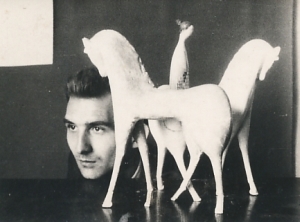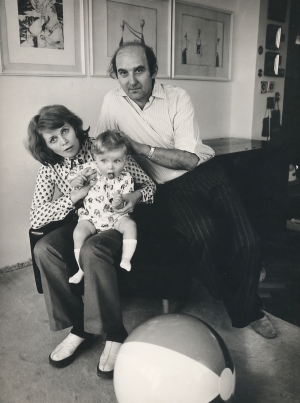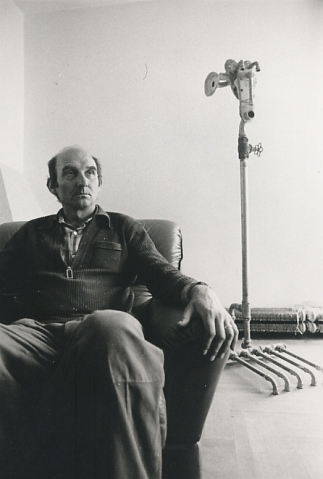Karel Nepraš | biography
He was born on 2 April 1932 in Prague where he lived and worked permanently and where he died on 5 April 2002.
1948-1951 Completed his studies at the School of Ceramics in Prague, where he found a lifelong friend in his classmate Bedřich Dlouhý, who later became a painter.
1952-1957 Studied at the Academy of Fine Arts in Prague, attending the school of sculpture of Prof. J. Lauda, where he befriended his colleague Jan Koblasa. In addition to Bedřich Dlouhý, who studied under Prof. K. Souček, he also made friends with Jaroslav Vožniak from the department of Prof. V. Silovsky (from 1954 on). This was the core of a dada-surrealist group, perhaps the first ever non-conformist artistic association, which responded to the absurd domestic social reality. This group was active not only in fine art, but also in the sphere of theatre, literature and music. Its first performance (the first `Malmuzherciade`) took place as early as 19 December 1954. Later (1957) the group was called the Šmidras (according to a comic figure of a policeman from a children`s puppet film). In addition to artists, an important figure of the group was in particular the composer Rudolf Komorous. The Šmidras were later joined by, for example, Aleš Veselý and Čestmír Janošek, and in the early 1960s by the art theorist Jan Kříž.

Late 1950s While still a student at the Academy of Fine Arts, Karel Nepraš entered the Czech artistic scene as a draughtsman. The special nature of his humorous drawings was to a certain extent an expression of the contemporary existential feeling as well as of Nepraš`s original, almost sarcastic vision of the human theme—such as the drawing Small Cruelty (1959). By their "strangeness" these works largely belong to the `Czech artistic grotesque`. Karel Nepraš later became one of its principal representatives. In the years 1958-1959 he created in the same spirit also illustrations to key literary works of Franz Kafka. In this period he made his first sculptures, which referred to his relationship to Giacometti (figures such as Standing I - II, both 1959).
1960 The first solo public exhibition of his works (al the ROKOKO theatre in Prague). In Jan Koblasa`s studio Karel Nepraš met for the first time with his lifelong friend Jan Steklík. In the following year (1961) they had their first joint exhibition (exhibition hall `Za pasáží` in Pardubice).
1962 Nepraš did his first work in the field of architecture, the handrail by the presbytery of St. Peter and Paul`s Church in Jedovnice near Blansko. Together with Nepraš, the artistic decoration of the interior of the church was done by Mikuláš Medek and Jan Koblasa.
1963 It was probably this year when Karel Nepraš and Jan Steklík founded their famous Křižovnická School of Pure Humour without Wit and they become its directors. It was a relatively comprehensive creative grouping. Its care consisted of prominent artists such as Nepraš`s wife, the graphic artist and sculptor Naďa Plíšková, the painters Rudolf Němec, Otakar Slavík, Zbyšek Sion and Olaf Hanel as well as Eugen Brikcius, Petr Hampl, the poet Andrej Stankovič, the translator Paul Wilson and art critics Ivan Jirous and Věra Jirousová. The Křižovnická School, which was in close contact with other personalities from the sphere of young authors of the 1960s (Ivan Wernisch, Petr Kabeš and others), was not united by a unified artistic idea, but rather a need for a creative dialogue. II took place in particular in the inspirational milieu of the Czech pub, which is characteristic for the Křižovnická School. The Křižovnická School survived the era of normalization and in a reduced form it exists up to the present day with one director and several prominent new supporters from abroad such as the artists Annegrel Heinl and Ben Patterson.
Early 1960s Nepraš`s sculptural oeuvre developed on the basis of Art informel. He created his first bronze and steel-copper reliefs as well mostly existentially felt sculptures on the theme of Kafka`s Castle (1963) and Portrait of Gregor Samsa (1964). Nepraš also continued to produce drawings and illustrations. He produced series of drawings such as Labyrinth of the World (1956-1961). Funeral Songs (1962) and Operation (1962-1963). He illustrated E. A. Poe`s Berenice. He began to publish his drawings and illustrations in the Brno journal Host do domu. From the 1960s to the 1980s he worked on the catalogue Series of Human Misfortune.
1964-1965 Nepraš did his first red Heads and Dialogues. Together with monstrous figures of Moroa of 1965 (Moroa is a fantasy character of a Šmidra novel written by members of the group as early as in 1958 made of piping, wire, fabric, stockings, etc. they represent an important landmark from the point of view of Nepraš`s subsequent oeuvre, especially sculptures, which with the years became more distinct and developed with discovery of creative improvement of new techniques and technologies.
1969-1971 Nepraš participated in the International Symposium of Spatial Forms in Ostrava (1969), where he discovered for himself a new sculptural material—cast iron. The result of the symposium was one of his most prominent sculpture compositions, The  Family Ready for Departure, which employed some simple motion mechanisms. The sculpture, which among other things impressively expressed the absurdity of emerging communist `normalization`, was removed from a park in the centre of Ostrava and was destroyed upon an official order in the early 1980s. In collaboration with the architect Petr Kupka, Nepraš created an aluminium relief placed in the underground passage in Prague at Můstek (1969-1971), which has been missing since the reconstruction carried out in the early 1990s. After a number of local and international exhibitions, Nepraš held an exhibition in the Špála Gallery in Prague, which was for a long time his last public presentation. In 1971 at the International Symposium of Ceramics in Hradec Králové Nepraš created two porcelain pieces. He returned to this material in a new mode in the 1990s.
Family Ready for Departure, which employed some simple motion mechanisms. The sculpture, which among other things impressively expressed the absurdity of emerging communist `normalization`, was removed from a park in the centre of Ostrava and was destroyed upon an official order in the early 1980s. In collaboration with the architect Petr Kupka, Nepraš created an aluminium relief placed in the underground passage in Prague at Můstek (1969-1971), which has been missing since the reconstruction carried out in the early 1990s. After a number of local and international exhibitions, Nepraš held an exhibition in the Špála Gallery in Prague, which was for a long time his last public presentation. In 1971 at the International Symposium of Ceramics in Hradec Králové Nepraš created two porcelain pieces. He returned to this material in a new mode in the 1990s.
1970s-1980s Due to normalization, Nepraš`s production lost its intensity. Instead of line art, he earned his living through restoration of historical works. Despite this a number of remarkable pieces came into being, in particular the series Portraits. They were assemblages, compositions made of various technical elements and items (rubber pipes, vessels, etc.), which represent specific people. This trend towards "portrait" culminated in the series Heads-Fountains from the 1980s, which consisted of ceramic sewage piping, cast iron and plumbing material.
1987 Thanks to the intervention of the painter Jiří Sopko, Nepraš was allowed to participate in the Art Fair in Basel, which became an impulse for new artistic activity resulting, for example, in the first versions of Snow White and the Seven Dwarfs (1988). In the late 1980s he illustrated Ladislav Klima`s book The Suffering of Count Sternenhoch (published by Paseka, 1990) and did a number of illustration, for example, for Franz Kafka Publishing House. In the late 1980s and the early 1990s he created balustrades at the stairways of the Lichtenstein Palace in Prague, including figural footstones in front of its facade.

1990 He began to teach at the Academy of Fine Arts in Prague; in the years 1991-2002 he taught there as a professor. In 1990 here originates one of his characteristic monumental compositions Wailing Wall.
1990s Karel Nepraš fully utilized his traditional materials, in particular ceramic pipes, piping and faucets, and also returned to porcelain.
1993-1994 Nepraš began his collaboration with the Zlín Gallery, which bore its first fruit in the large-scale composition Dialogue VIII (Lightning Rod), created within the framework of the symposium Prostor Zlín 94 (originally in Milada Horáková Park in the centre of Zlín, now in front of Alternativa - Cultural Institute Zlín). In the early 1990s Karel Nepraš participated in the Ceramic Symposium in Louny, where he established an important contact with the ceramic artists Ivan Jelínek, resulting in Nepraš`s numerous compositions made of electrical porcelain such as a series of reliefs (Temelín, Drying Up Landscape) as well as a series of busts and a series of toilets.
1999-2002 Nepraš participated in the symposium in Greiz, where he created monumental cast iron figures, followed by other large-scale figure compositions of his closing creative period using cast iron and plumbing pipes Walking, Reclining, Standing (Egypt-Giacometti-Nepraš) and Confluence of the Elbe and the Vltava. In the late 1990s he won a competition for a monument to the writer Jaroslav Hašek to be erected in Prague-Žižkov. However, this riding monument to Hašek was finished after Nepraš`s death by his daughter Karolína Neprašová in 2005.
Karel Nepraš died on 5 April 2002 in Prague.
© 2012 - Karolína Kračková Neprašová - kneprasova@seznam.cz | webdesign - KD


